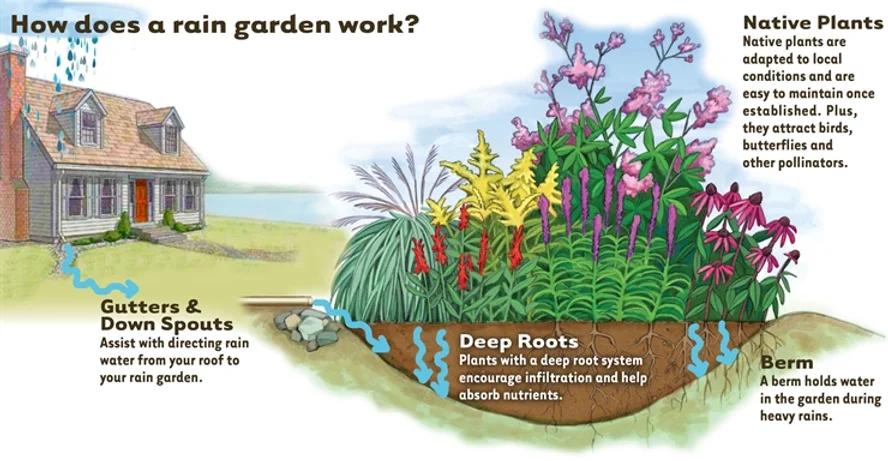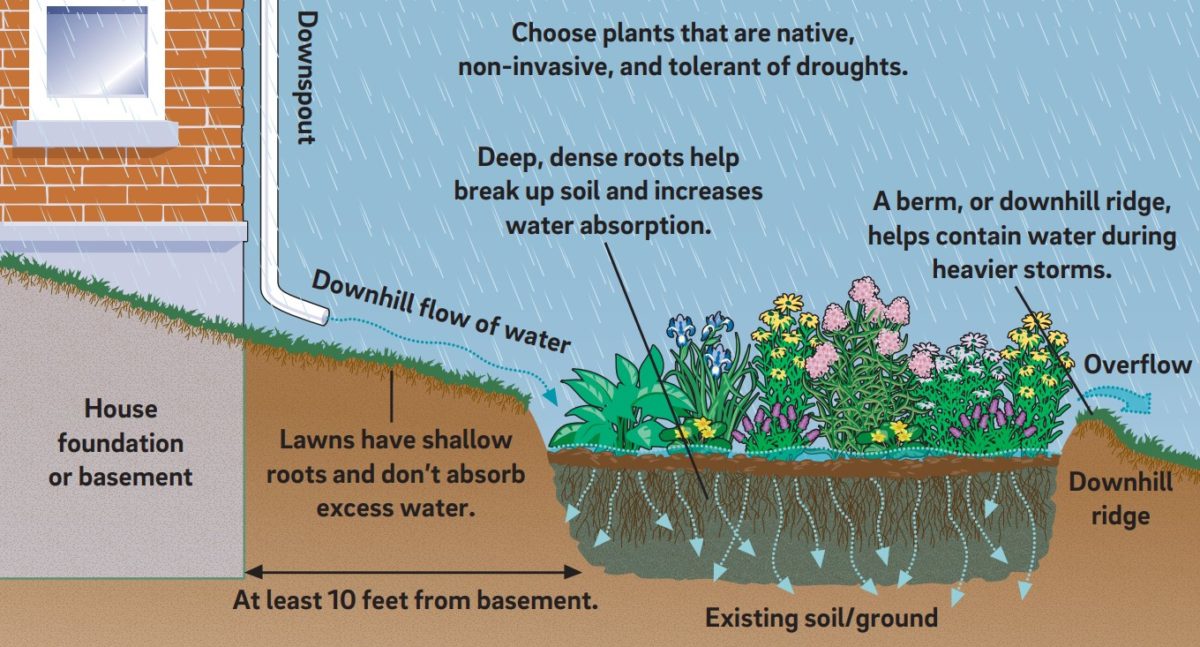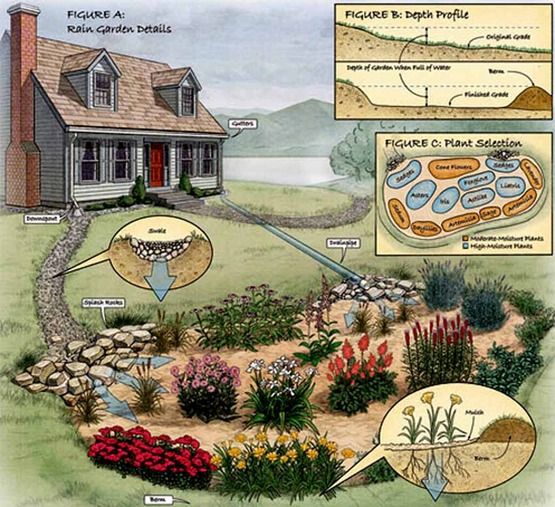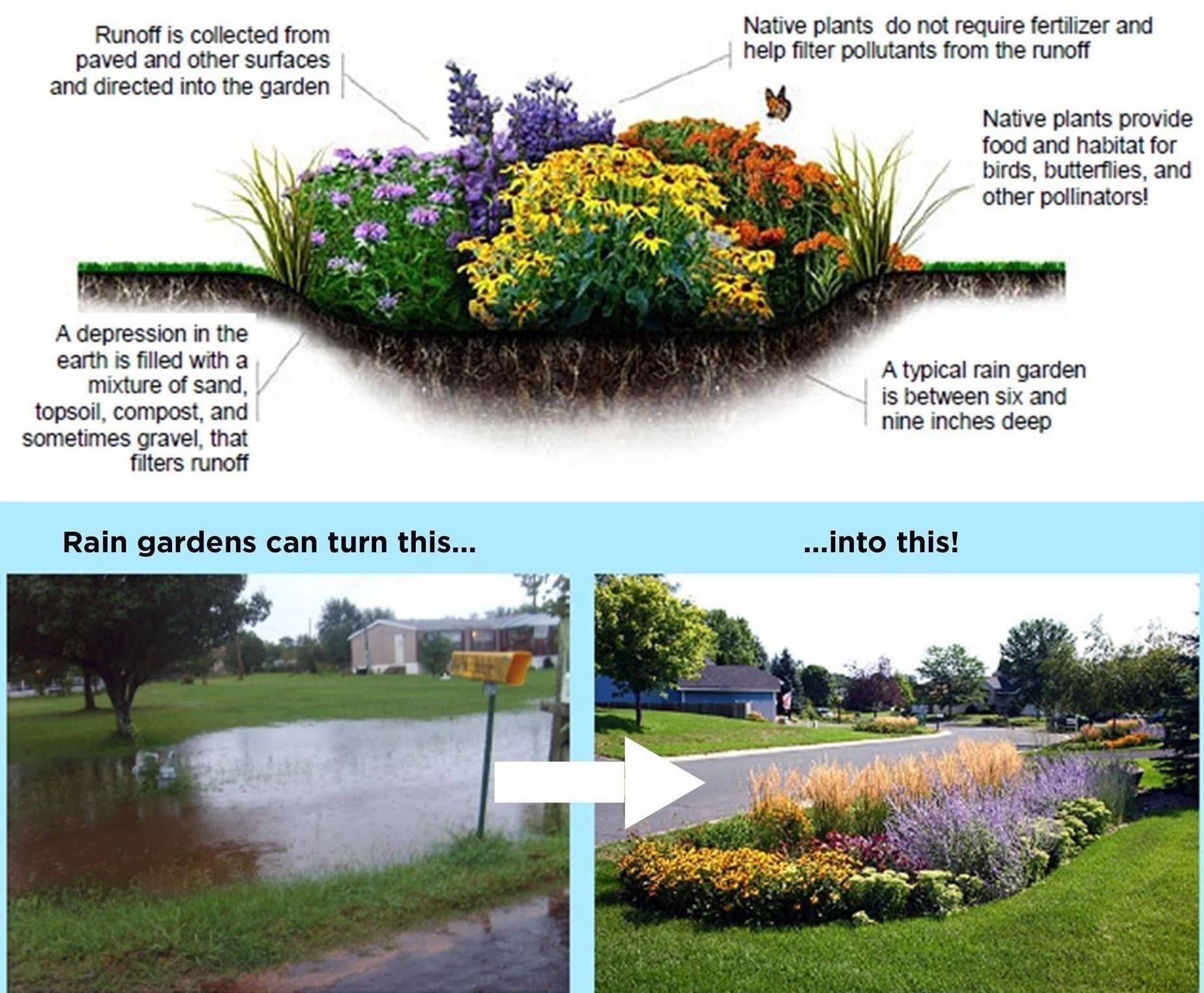Rain Gardens 101: How a Rain Garden Can Benefit Your Yard
By Sarah Finazzo • April 1, 2024

Rain gardens are a simple and effective way to help protect our environment while enhancing the beauty and functionality of your yard. These gardens capture and filter rainwater runoff from impermeable surfaces like rooftops and driveways, preventing pollutants from entering local waterways and recharging groundwater supplies.
By incorporating a rain garden into your landscape, you can help address issues related to urbanization and climate change while creating a sustainable and beautiful garden in your outdoor space.
In this blog post, we will explore how rain gardens work, why they are beneficial and how to build a rain garden!
How Rain Gardens Work
Rain gardens work by capturing and filtering rainwater runoff from rooftops, driveways, and other impervious surfaces. They are designed to collect rain water in shallow depressions, where it can slowly infiltrate into the ground, replenishing groundwater supplies.
The garden's soil and plant roots filter pollutants and contaminants from the water, preventing them from entering local waterways. The depth and design of the garden are carefully selected to ensure optimal drainage and filtration, with plants specifically chosen for their ability to thrive in wet conditions.
By managing stormwater runoff, rain gardens help prevent flooding, erosion, and water pollution while promoting sustainable water use and supporting local ecosystems.

Choosing Plants for Rain Gardens
When choosing plants for a rain garden, it's important to select species that are adapted to wet conditions and can filter pollutants from the soil. Here are some tips to help you choose the right plants:
- Select native plants: Native plants are adapted to the local climate and soil conditions and are more likely to thrive in a rain garden. Include wetland plants that are suited for wet soil.
- Choose plants with deep root systems: Plants with deep roots can absorb water and nutrients more effectively and help stabilize the soil.
- Include a mix of plant types: A diverse mix of plants, including grasses, shrubs, and perennials, can help provide different layers of filtration and maximize the garden's effectiveness.
- Consider bloom time: Choose plants that bloom at different times throughout the year to provide interest and beauty in the garden year-round.
- Check plant labels: Look for plants labeled as "wetland" or "rain garden" plants, as these species are well-suited for wet conditions (as mentioned above).
What is a good rain garden site?
The location of your rain garden should be carefully selected to ensure that it can effectively manage runoff water. The garden should be located at least 10 feet away from your home's foundation and a septic tank or wells, and it should be large enough to capture runoff from impervious surfaces like rooftops, driveways, and sidewalks.
The size of your rain garden will depend on several factors, including the amount of rainfall in your area, the size of the drainage area, and the soil type in your yard. Here's how you can determine size:
- Calculate the drainage area: Identify the surfaces that will drain into the rain garden, such as rooftops, driveways and paved surfaces. Measure the length and width of each surface and multiply these measurements to get the total drainage area in square feet.
- Determine the soil type: The size of your rain garden will depend on the type of soil in your yard (clay? silty? sandy soil?) . You can perform a simple soil test called a ribbon test to determine your soil type.
- Use a rain garden calculator: Once you have determined your drainage area and soil type, you can use a rain garden calculator to determine the appropriate garden size.
In general, the size of your rain garden should be at least 10% of the total drainage area, but it may need to be larger if you have heavy clay soils or if you receive a lot of rainfall.

Shape of a Rain Garden
The shape and slope of the garden should be designed to allow water to flow naturally into the garden and to promote optimal drainage. The garden should be concave in shape, with a slope of 2-5% to allow water to flow into the garden but not pool into standing water on the surface. Most rain gardens are oval or bean shaped. You can play with the shape by laying out your garden hose or using rocks or chalk to outline.
Soil for a Rain Garden
The soil in your rain garden should be composed of a mix of sand, compost, and topsoil to promote optimal drainage and filtration. The soil should be at least 3 feet deep to allow for deep plant roots.
Steps for Installing Rain Gardens
If you are considering installing a rain garden in your yard - here are some things you will need to think about!
- Choose the location: Choose a location in your yard where water naturally flows and pools. Again, the location should be at least 10 feet away from your home's foundation and any wells or septic systems.
- Prepare the site: Remove any grass or vegetation from the site and dig a shallow depression that is about 6-12 inches deep. Make sure the depression is concave in shape, sloping slightly toward the center.
- Add soil amendments: Add a layer of sand, compost, and topsoil to the depression to create a soil mixture that will promote optimal drainage and filtration. As noted, the soil mixture should be at least 3 feet deep.
- Choose and plant the right plants: Select native plants that are adapted to wet conditions. Place the plants in the depression, spacing them according to their mature size, which will be noted on the label.
- Mulch and water: Add a layer of mulch around the plants to help retain moisture and suppress weeds. Lighter mulches such as pine bark and straw may float and could be washed to the edges of a garden. Try a more dense materials such as pine straw, wood chips or shredded wood. Water the garden thoroughly after planting, and continue to water as needed until the plants are established.

What Kind of Maintenance Does a Rain Garden Require?
Regular maintenance is key to keeping your rain garden healthy and functioning properly. This includes removing any weeds or debris, monitoring the garden for drainage issues, and replacing any plants that do not thrive.
Do rain gardens attract mosquitos?
By design, water should not stand in a rain garden for longer than 24 hours after a rain event. Mosquitoes do not complete their breeding cycle in this 24-hour period of time, so a rain garden should not increase or attract mosquito populations.
It is important to make sure your rain garden is draining well to keep it functioning properly!
Do rain gardens really work?
Yes! When done correctly, rain gardens are effective at managing stormwater runoff and improving water quality. Studies have shown that rain gardens can reduce stormwater runoff by up to 30%, depending on the size and design of the garden. Rain gardens are a sustainable and effective way to capture water and promote healthier ecosystems. By incorporating a rain garden into your yard, you can help to protect local water resources and enhance the natural beauty of your landscape.
Installing a rain garden can be extremely rewarding! Have fun with it!


 Xerces Society, AdrianDanciu
Xerces Society, AdrianDanciu US Airforce Image
US Airforce Image
About Tilly
Tilly’s easy online landscape design process has been embraced by homeowners across the country and in Canada. Tilly breaks packages into the Front Yard, Backyard or your Full Yard. We match you with a professional landscape designer who is familiar with your region to create the perfect custom plan for your outdoor space.
To start our process you’ll fill out a questionnaire about your property that helps our design team understand your goals, needs and existing landscape. You can add 3d renders, lighting plans or side yards to your design package. You’ll then meet with your designer on a video call, show them your space and discuss your priorities.
Whether you are just looking to add some curb appeal or transform your entire backyard - we have a team for you!
Read more about: Landscape Design Tips, Sustainable Design